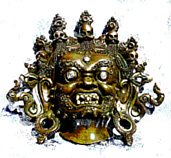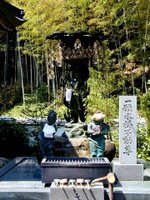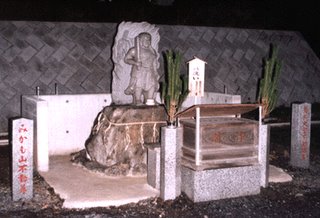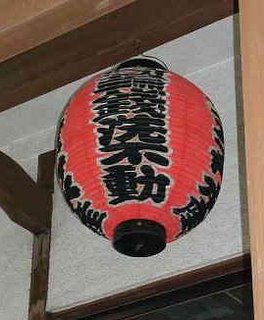:::::::::::::::::::::::::::::::::::::::::::::::::::::::::::::::::::::::::::::::::::::::::::::::::::::::::::::::::::::::::::
Four-armed Fudo 四臂不動尊 shihi Fudo Son
These statues are quite rare.
:::::::::::::::::::::::::::::::::::::::::::::::::::::::::::::::::::::::::::::::::::::::::::::::::::::::::::::::::::::::::::
. Choorakuji 長楽寺 Choraku-Ji .
Shimoda

- source : blogs.yahoo.co.jp/kanmankiriku
:::::::::::::::::::::::::::::::::::::::::::::::::::::::::::::::::::::::::::::::::::::::::::::::::::::::::::::::::::::::::::

source : kyobibutsuzou.com
:::::::::::::::::::::::::::::::::::::::::::::::::::::::::::::::::::::::::::::::::::::::::::::::::::::::::::::::::::::::::::
Famous Statue at the temple Hokke-Ji in Kyoto.
This temple is the first of the five big nunnaries in Kyoto since ancient times.

「迦楼羅」は「法隆寺玉虫厨子」の貴重 な絵画にも描かれております。
「台座」は「瑟瑟(しつしつ)座」で迦 楼羅炎と同じく、不動明王専用です。
「ガルーダー」はインドネシアの国鳥で したが今は違います。
「不動明王像」は「慈光殿」に安置され ております。
http://www.eonet.ne.jp/~kotonara/hokkejinoohanasi.htm
:::::::::::::::::::::::::::::::::::::::::::::::::::::::::::::::::::::::::::::::::::::::::::::::::::::::::::::::::::::::::::
Fudo with four faces, four arms and four legs
Painting, Kyoto National Museum
76.4 cm long
四面四臂四足不動明王像 <京都国立博物館蔵>

http://www.kyohaku.go.jp/jp/dictio/data/kaiga/kujaku01.htm
通常の不動図像は一面二臂二足だが、本作品は多面多臂(臂は腕のこと)多足という珍しい姿である。異形不動といってよい。他の不動図像集の中には、本作品と同じものが見られ、もとは十世紀後半に活躍した源朝 が描いた形とされている。すぐれた筆描と火炎の動勢表現が見事である。
Normally, Fudo has only one face and two arms/legs. This painting from the Edo period is indeed special.
http://bunka7.nii.ac.jp/SearchDetail.do?heritageId=82566
:::::::::::::::::::::::::::::::::::::::::::::::::::::::::::::::::::::::::::::::::::::::::::::::::::::::::::::::::::::::::::
The Heavenly Houses and the Mystery of the Number Four
宿曜経(すくようきょう,(しゅくようきょう))
一般に易学では、天の周(めくり)を360度に区分しますが、宿曜経では108足に割り付けます。
108足を二十七宿に割り付けると一宿は四足となります。
108/27=4
一般的な易学の二十八宿では無く、古法二十七宿を意味しております。
この宿曜経へのヒントは、日蓮宗総本山・中山法華経寺(千葉県市川市)の四足門(重要文化財・室町後期作)の四足と言う言葉との出会いでした。
四本柱から会陽と云う行事が、宿曜経をベースにして創作された行事であることがわかります。
仏画としては、四面四臂四足不動明王(京都市博物館所蔵)が知られています。この仏画は、鎌倉時代の紙本白描(無着色の絵)とのことです。
四本柱と言うのは、あくまでも俗称です。除夜の鐘の108は、宿曜経の108足に由来しています。宿曜経は、日本人の生活にとけ込んでいる経典です。806年(大同元年)に空海が唐より宿曜経を含む大量の仏教経典を日本にもたらしました。宿曜経に書かれていた七曜が当時の陰陽寮の上層部に注目され、公式の暦に記載されるようになりました。
恩田様より、重要な情報が寄せられました。
宿の四足については、原語のパーダに「四分の一」という意味とともに「足(foot)」という意味もあるので、仏典では「足」と訳しています。一行禅師の大日経疏(巻第四)には、「周天凡一百八足、毎宿均得四足、即是月行一日程、経二十七日、即月行一周天也」と記されています。
http://mryanagi.hp.infoseek.co.jp/new_page_4.htm
:::::::::::::::::::::::::::::::::::::::::::::::::::::::::::::::::::::::::::::::::::::::::::::::::::::::::::::::::::::::::::
. Nr. 41 天長寺 Tenchooji 天長寺 Tencho-Ji .
Temple Nr. 41 Tenchooji 天長寺 Tenchoji, Tencho-Ji
At the Kyushu Henro Pilgrimage, Miyazaki
第四十一番 松林山 天長寺 宮崎県都城市都島町
The Fudo statue is one of the Secret Statues and not shown in public.
There is another Fudo stone statue at this temple garden.
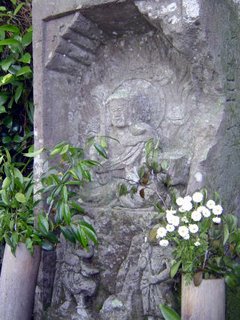
- source : btvm.ne.jp
:::::::::::::::::::::::::::::::::::::::::::::::::::::::::::::::::::::::::::::::::::::::::::::::::::::::::::::::::::::::::::
Juuniten Mandala
At the Temple Kokubunji in Shimonoseki.
In the middle of the mandala is a Fudo with four arms. It dates from the Kamakura Period.
けんぽんちゃくしょくじゅうにてんまんだらず(じでんあんちんまんだら)
絹本著色十二天曼荼羅図 (寺伝安鎮曼荼羅) Important Cultural Property.
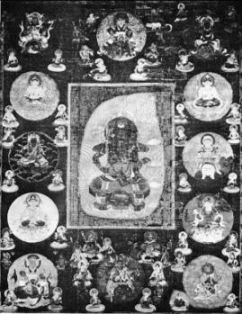
この十二天曼荼羅図は、中央に大きく四臂不動明王を配し、すぐ外院に十二天を廻らしていて、さらにその周囲にいろいろの仏像を描いている。彩色が美しく、しかも不動の膝をはじめ処々に切金(きりがね)が施されている。その切金文様の様式や、不動の光背の火炎が形式化していることなどから判断して、この図は鎌倉時代の製作と見るべきであろう。
下関市の国分寺にあります。寸法は、たて173cm、横130cmです。
http://bunkazai.ysn21.jp/general/summary/genmain.asp?mid=40004&cdrom=
About the 12 Heavenly Deities
The 12 Ten are the 12 Tenbu (deva guardian). They are the deities of the 8 directions(East: Taishaku Ten, South: Enma Ten, West: Sui Ten, North: Bishamon Ten, East south: Ka Ten, West south: Rasetsu Ten, West north: Fuu ten, East north: Ishana Ten), the two directions(Up:Bon Ten, Down:Chi Ten) and Nitten (the sun) and Gatten (the moon).
They are composed with deities who control the universe, ruling over all of Tenryu (dragon in heaven) , Kishin (demon), Seishuku (constellation), and Meikan (hell).
When worshipped on the circle platform, a Fudou Myou Ou with four arms should be placed.
http://www.butuzou.co.jp/english/juniten.html

- source : taogakusya.blog12.fc2.com
十二天曼荼羅 Juniten Mandala

:::::::::::::::::::::::::::::::::::::::::::::::::::::::::::::::::::::::::::::::::::::::::::::::::::::::::::::::::::::::::::
The Celestial Houses and the Number FOUR
"These kingdoms have not arisen from outside.
They arise from the four divisions of your heart."
(Bardo Thödol [Tibetan Book of the Dead])
Dominion, or the System of 8 Houses by Patrice Guinard, Ph.D.
The astrological houses in the celestial sphere. Vishnu has four arms and manifests through a theoretically infinite number of avatars that regenerate the world.
ooo ooo ooo ooo ooo ooo ooo ooo
The mention of Rahu, the demon of eclipse, which originally had four arms and a tail that was severed by Vishnu to become Ketu (comet) is interesting in that the demon is here darkening Kirttika (the Pleiades) in the month of Karttika (latter half of October, through mid November), for the tale goes on to relate that ...
Read about the COMETS connection here:
Comets and the Bronze Age Collapse, by Bob Kobres
:::::::::::::::::::::::::::::::::::::::::::::::::::::::::::::::::::::::::::::::::::::::::::::::::::::::::::::::::::::::::::
............................................. FOUR
Four is the 4th dimension = time which is illusion.
Four is seen as the first solid number. Spatial in scheme or order in manifestation.
Static as opposed to the circular and the dynamic.
Wholeness; totality; completion; solid
Earth; order
Rational - relativity and justice
Symbol of measurement
Foundation
The are four cardinal points; four seasons; four winds; four directions (as in North, South, East, West); four elements (Fire, Water, Air, Earth) in the western culture.
There are four sides to a square; four arms to a cross. There are four rivers to Paradise, that formed a cross (the Garden of Eden was said to be within the four rivers). Within Paradise were four infernal regions, seas, and sacred mountains. There are four watches of the night and day, quarters of the moon.
There are four quarters to the earth. There are four tetramorphs. The Divine Quaternity is in direct contrast to the Trinity. Four is a symbolic number used throughout in the Old Testament. The quaternary can be depicted as the quatrefoil as well as the square and the cross.
Cultural References
Native American: As in other cultures, ceremonies and ritual acts are repeated in fours. The Native Amercican cultures have used the number 4 most frequently as in the four cardinal directions. The four winds are depicted by the symbol of the cross and by the symbol of the swastika. The swastika as some misbelieve was not created by Hitler. It was instead borrowed from the Native American and occult beliefs of which Hitler had great interests. Hitler derived his "insanity" of power from his misdirected interpretation and use of metaphysical principles. He used knowledge that his human consciousness couldn't possibly understand and the use of this knowledge for personal gain is part of the imbalance that creates the chaos and karma.
Buddhism: The Damba Tree of Life has four limbs and from its roots four sacred streams of Paradise that represent the the four boundless wishes of compassion, affection, love impartiality. It also represents the four directions of the heart as well.
Chinese Buddism: there are four celestial guardians of cardinal points are Mo-li Ch'ing, the East, with the jade ring and spear; Virupaksha, the West, the Far-gazer, with the four-stringed quitar; Virudhaka, the South, with the umbrella of choas and darkness and earthquakes; Vaisravenna, the North, with the whips, leopard-skin bag, snake and pearl.
Chinese: Four is the number of the Earth, symbolized by the square. There are four streams of immortality. Four is even an number. It is Yin in polarity.
Christian: Four is the number representing the body, with three representing the soul. Again we see the theme of the four rivers in Paradise. There are four Gospels, Evangelists, chef arch-angels, chef-devils, four Fathers of the Church, Great Prophets. There are four cardinal virtues--prudence, fortitude, justice, temperance. The are four winds from which the One Spirit is said to come. There are four horsemen of the Apocalypse.
Revelation: There four angels standing at the four corners of the Earth, holding back the four winds of the earth (Rev 7:1). The great multitude from every nation, tribe, people and language (four-fold description) - Rev 5:9 11:9 13:7 14:6 the four-fold description indicates that these people come from all over the earth.
Egyptian: Four is the sacred number of Time, measurement of the sun. Four pillars support the vault of heaven. There are four canopic jars placed around the dead at the four corners guarded by the four sons of Horus who are associated with the cardinal points. In the Hermetic it is the divine quaternity. It represents God.
Gnostic: belief in Barbelo, the Four-ness of God.
Greek: Four is the sacred number of Hermes.
Hebrew: Four represents measuring; beneficence; intelligence. In the Kabbalah four is memory; four represents the four worlds of the Kabbalah.It also represents the four directions of space and the four levels of the hierarchical organism of the Torah.
Hindu: Four is Totality; plenitude; perfection. Brahma, the Creator is four faced. The temple is based on the four sides of the square, symbolizing order and finality. There are four tattvas the four bodies bodies of human and kingdoms of nature which are animal, vegetable, mineral, mind. There are four yugas. Four is the winning throw of the dice. There are four castes and pairs of opposites.
Islamic: tradition the four terms of the quaternary are the Principle which is Creator; Universal Spirit; Universal Soul; and the primordial matter. These correspond to the four worlds of Kabbalism. There are four angelic beings and four houses of death. There are four levels to the Bardo.
Mayan culture four giants support the celestial roof. Four is seen as the number of support .
Pythagorean: Four is Perfection; harmonious proportion; justice; the earth. Four is the number of the Pythagorean oath. Four and ten are divinities. The Tetraktys 1+2+3+4=10.
Scandinavian: there are four rivers of milk flowing in Asgard.
Sumero-Semitic: Four astral gods are indentified with the four cardinal points.
Teutonic: Four dwarfs support the world.
Taoist: There are four celestial guardians, Li, with the pagoda; Ma, with the sword; Cho with two swords; Wen with a spiked club.
More about the Symbolism of Numbers in this outside LINK
http://www.crystalinks.com/numerology2.html
:::::::::::::::::::::::::::::::::::::::::::::::::::::::::::::::::::::::::::::::::::::::::::::::::::::::::::::::::::::::::::
[ . BACK to DARUMA MUSEUM TOP . ]
[ . BACK to WORLDKIGO . TOP . ]
:::::::::::::::::::::::::::::::::::::::::::::::::::::::::::::::::::::::::::::::::::::::::::::::::::::::::::::::::::::::::::

